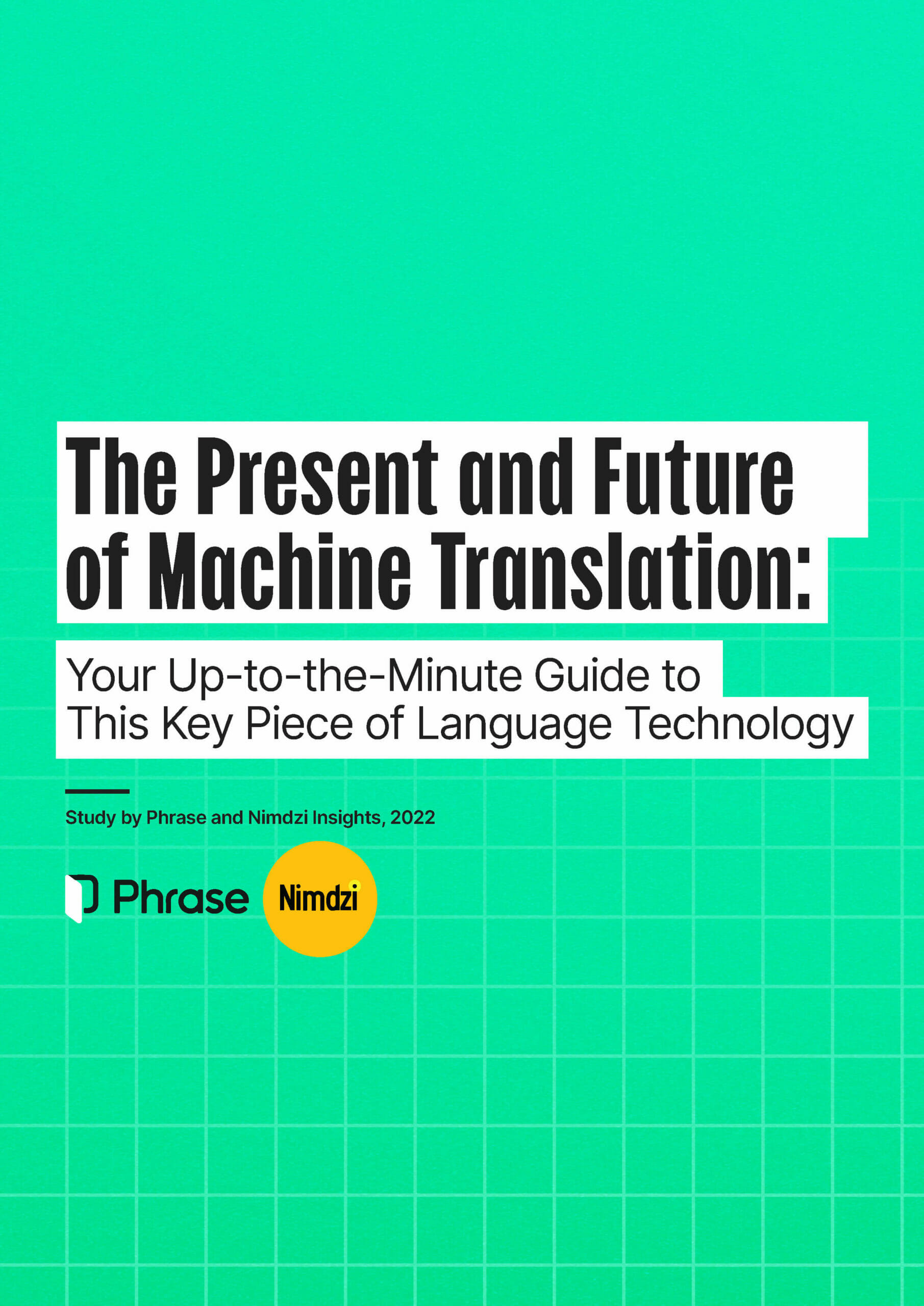Machine translation
Enterprise Machine Translation: 4 Tips for Future-Proof Implementation

In a globalized world, where local markets and consumer preferences evolve every day, growing companies have long moved beyond the why of using machine translation (MT). With continuous improvements in quality, MT has risen to a viable productivity tool for entering new markets more quickly while keeping costs low.
Nevertheless, questions still swirl around the how of implementing machine translation into globalization strategies, with no single approach being clearly dominant. What are common use cases for MT in the modern enterprise environment? How do you deploy machine translation, reduce error risk, and assess its business impact?
If you, too, are looking for answers to these questions, you’ve come to the right place. To provide you with hands-on insight and help create future-proof implementation strategies, we’ve put together this roadmap addressing the most immediate challenges and opportunities of enterprise machine translation.

Download for free
Your up-to-the-minute guide to machine translation
Learn about new technologies to improve machine translation output quality, the latest on MT post-editing pricing models, and how to best shop for machine translation.
What business areas can machine translation best serve?
Today, machine translation is well-positioned to serve almost any aspect of the business world that requires translation. That said, two core areas where MT has been increasingly helpful are customer interactions and intracompany communication (e.g., employee-to-employee). Let’s have a closer look at both.
Customer interactions
Traditionally, large enterprises have significantly invested in human translation for their customer-centric or “outbound” content. This, however, is no longer the only option—MT can play a major role in relatively new inbound (customer-to-enterprise) and sidebound (customer-to-customer) content types.
Whether social media interactions, customer feedback, or online reviews, all of this user-generated content (UGC) offers invaluable insights into how customers may think and feel about a product. Still, with its ever-growing volume, UGC often proves impractical for human translation. This is where MT can play a key role with its ability to process large content volumes quickly.
When enterprises use MT alongside other natural language processing (NLP) tools, like sentiment analysis, marketing departments can get an even better understanding of the in-country sentiment around their products.
Tip: Using machine translation alongside sentiment analysis can provide the deepest possible understanding of a company’s international markets.
Unlock the power of machine translation
Discover advanced machine translation management features within our enterprise-ready TMS and create new business opportunities worldwide more quickly and efficiently.
A company that has already taken the plunge in this sense is TripAdvisor, using machine translation to translate billions of words in customer reviews every year. This has helped the company increase the value they bring to its customers and also improve its overall business performance.
The improvement in neural machine translation has particularly helped brands featuring customer reviews translate UGC at scale without the need for human supervision. For companies like TripAdvisor and others relying heavily on UGC, neural MT has been a game changer—users stick around longer, on-page advertising revenue increases, and brand loyalty gets a boost.
The key to making the most of MT in this area is to meticulously distinguish between content types and think about the utility of the content for the end user. This is the most reliable way for decision-makers to create pipelines of content for raw machine translation vs content that you may need to run through a trained MT engine or get translated by a professional linguist.
Intracompany communication
It’s not uncommon for enterprises to expand into markets whose languages the business hasn’t covered before. Using machine translation here to facilitate employee-to-employee or employee-to-HR communications can enable quick and efficient collaboration, sharing feedback and documents, or even participating in meetings across language barriers.
As an enterprise expands into new countries, it’s essential to make sure that internal communications are as seamless and efficient as possible. When the language of the headquarters is different from the language spoken by branch employees, machine translation helps bridge the gap.
Tip: Using machine translation for inter-office and intercultural employee communications, such as HR documents, office circulars, meeting notes, feedback forms, policies, etc., makes for a smoother and more efficient workflow.
DEI values—diversity, equality, and inclusivity—involve ensuring that all voices are heard, regardless of language, and MT makes that possible. When companies use MT to provide a multilingual experience for their employees, not only does it create a more inclusive work environment, but it also helps employees understand each other better and creates an opportunity for closer collaboration.
Deploying machine translation
The success of localization efforts that make use of machine translation hinges on how successful the deployment is across the business. Following inefficient workflows or mismatching a certain MT approach to the content type can lead to a failed initiative quickly, costing the business time and money.
When it comes to deploying machine translation, there are several considerations to take into account:
- What content is suitable for raw machine translation?
- When to use generic and custom MT?
- What level of post-editing does the content at hand require?
- What infrastructure should there be in place to distribute machine-translated content?
The answer to all of these questions depends on the utility of the content. For standard content that aims to inform, such as support documentation or knowledge bases, then raw MT can do the job. However, content containing emotional elements—marketing campaigns, for example—requires more finesse, so using professional linguists may be a better option.
To avoid costly mistakes and maximize the value of translation efforts, taking a practical approach to the deployment of MT is essential. For instance, instead of overthinking the process, running a simple translation test and seeing how raw MT performs with the content in question can provide useful insights. If the results are satisfactory, it’s safe to leave it at that. If the output needs some improvement, making use of a machine translation glossary before investing in training a custom MT engine can be the right solution.
Tip: If raw machine translation does the job well for a particular content type, there’s no need to rush into the overinvestment of training a custom MT engine.
Another tip for large enterprises is to have an infrastructure in place that allows them to bring the machine-translated content to the consumer. Thinking of all the content types they need to translate and the directions in which this content needs to flow (HR documents, marketing campaigns, customer support) may help enterprises identify the best infrastructure for their needs.
For example, if the company is using a chat system, it’s worth considering its capabilities for injecting the translation directly into the conversations without delay or the need for manual intervention. Or, if operations rely on a specific HR system, thinking of whether it can support MT and how to deploy it may help unlock yet another benefit. In any case, the most important aspect here is to create a reliable feedback loop to monitor the effectiveness of your translations.
When it comes to raw vs. custom MT, the answer is pretty simple. The best approach is to use custom MT for any content where the enterprise needs to maintain its brand voice and tonality. UGC, however, is too diverse and unpredictable, so custom MT may not work best. Instead, using raw translation with a disclaimer that the text is machine-translated could be the way to go.
Error risk reduction
Despite its rapid advancement, machine translation still comes with a potential risk of grammatical or semantic errors. For sustainable results, companies need to work out a system that will not only reduce the risk of such errors but also manage the damage those errors can cause if left unattended.
Some best practices for minimizing the risk of errors include:
- Paying attention to data curation: A company needs to pay close attention to its language data and throw out anything that might be bad: alphanumeric data, data with alignment issues, etc. In fact, it’s pretty common for organizations to discard 5-10% of all data that customers provide to keep their MT engine clean.
- Using a blocked words list: Another simple yet effective practice is to create a list of blocked words that shouldn’t appear in the output. This ensures that, when translations go through the MT engine, any curse, insulting, offensive, or vulgar words will be flagged.
- Quality estimation: A more sophisticated approach is to rely on automated quality estimation, where part of the neural network provides an estimate of how good a certain translation may be. This can be a simple comparison between the translation and existing training material or looking at the difference between the MT output and the post-edited output, i.e. the edit distance.
- Page disclaimers: Regardless of how well-prepared a company is, errors or misalignment in MT are often inevitable. That’s why, to manage user expectations better, a page disclaimer as simple as “This page has been machine-translated” can prove very powerful. Adding a button or a widget to the page for users to flag incorrect text or even edit it themselves can also help.
Assessing the business impact of machine translation
Translations always need to serve a clear business purpose—whether it’s promoting a product in a new target market or understanding how customers may feel about a certain offering— but how can companies decide on which metrics to follow?
A good first step is to set up a system that tracks what truly matters to the business. This could be customer acquisition rates, conversion rates, user engagement, or any other kind of metric that is meaningful for the business. This way, it’s easy to see whether certain changes have a positive effect on these metrics and make adjustments accordingly.
When defining the metrics to monitor, 2 key areas worth looking at are the accuracy of MT and the impact it has on the business.
When it comes to assessing the actual accuracy of MT, some automated metrics like chrF, BLEU, or COMET can provide valuable insights. To improve deployment time or linguists’ productivity, the number of changes they’ve made in a specific timeframe during machine translation post-editing can be a further indicator of MT output quality and of workflow efficiency.
In terms of assessing the value that MT brings to the business, it’s a good idea to look at some real-world metrics that can help provide more tangible evidence. For example, a travel booking platform localizing recent user reviews could notice that users spend more time on the site and bounce less—ultimately leading to more bookings through the platform.
Tip: It’s important to go beyond linguistic quality and look at the business results that translating content may produce. If the result is what was expected, then it’s a good translation.
The future of machine translation
Machine translation is at the edge of truly revolutionizing global business. The industry is already seeing a wider application of NLP in areas like automated transcription, text-to-speech conversion, automated interpretation, or sign language translation—and things don’t stop there.
The use of metadata, like information on audience or text purpose, can further refine machine translation output. Machine translation quality estimation is also on the rise and is expected to enable companies to publish machine-translated text even without human review.
An even greater language coverage and refinement in neural MT is another expected development—with engines taking a whole document into account to produce quality translations.
Finally, MT can be used to power other artificial intelligence tools that rely on natural language processing. This may open up the door for the development of many other intelligent systems that go beyond translation.






